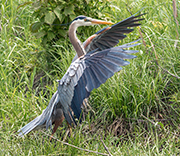
Great Blue Heron (Ardea herodias)

- HABITAT - Great Blue Herons forage in marine coastal environments and in freshwater habitats, but nest on islands or in wooded swamps, where few mammals or snakes can prey on them. The birds sometimes nest alone, but often do so in colonies consisting of a dozen to several hundred pairs.
- Great Blue Herons is found throughout most of North America, as far north as Alaska and the southern Canadian provinces in the summer. In winter, the range extends south through Florida, Mexico, and the Caribbean to South America. Northern birds that are east of the Rockies migrate to the coastal areas of the Southern for the winter.
- DIET - Although they will eat just about anything that that can catch that will fit in its gullet, Great Blue Heron’s main food is small fish less. It will also eat shellfish, insects, rodents, amphibians, reptiles, and small birds.
- FACTS - Great Blue Herons nest in colonies. The build platform nests out of sticks. Male chooses the nest site and displays there to attract a mate. The female mostly builds the nest. Both parents incubate the eggs, and feed the young regurgitation. Young capable of flight at about 60 days, depart nest at about 65-90 days.

























